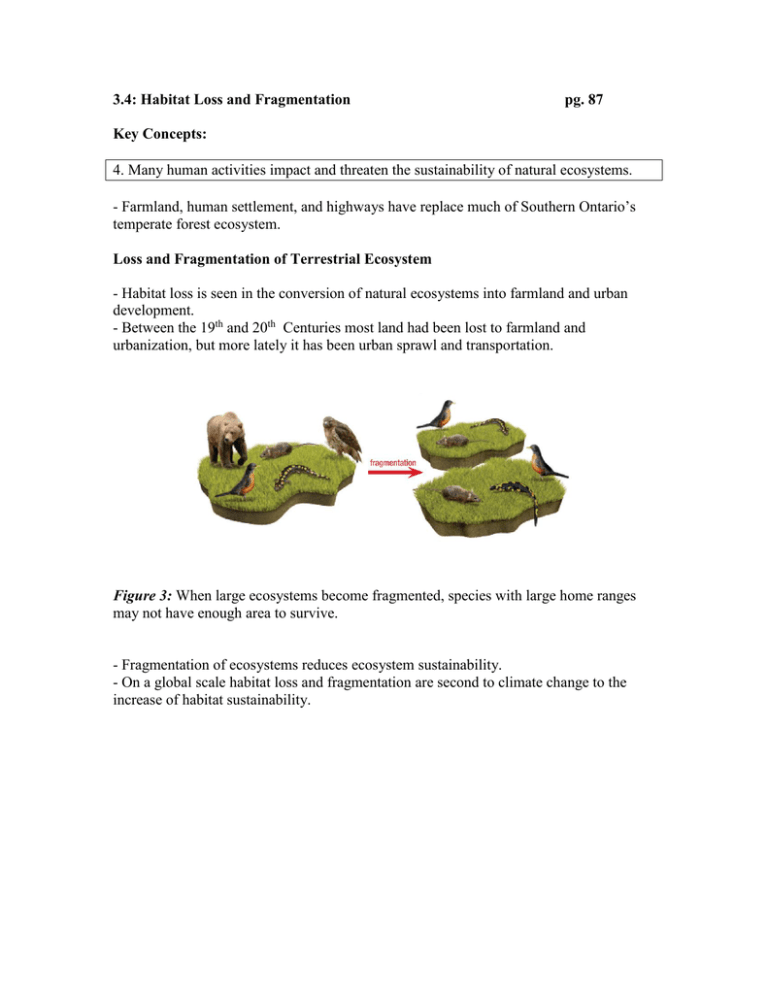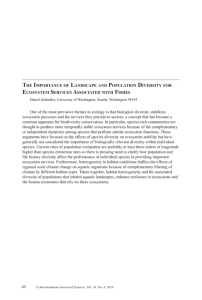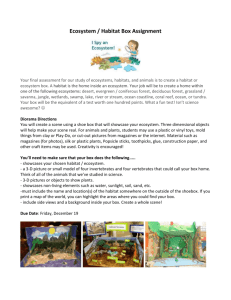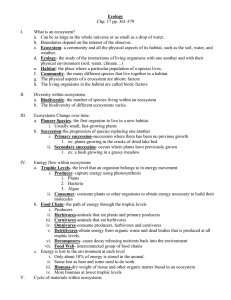3.4: Habitat Loss and Fragmentation pg. 87 Key Concepts:
advertisement

3.4: Habitat Loss and Fragmentation pg. 87 Key Concepts: 4. Many human activities impact and threaten the sustainability of natural ecosystems. - Farmland, human settlement, and highways have replace much of Southern Ontario’s temperate forest ecosystem. Loss and Fragmentation of Terrestrial Ecosystem - Habitat loss is seen in the conversion of natural ecosystems into farmland and urban development. - Between the 19th and 20th Centuries most land had been lost to farmland and urbanization, but more lately it has been urban sprawl and transportation. Figure 3: When large ecosystems become fragmented, species with large home ranges may not have enough area to survive. - Fragmentation of ecosystems reduces ecosystem sustainability. - On a global scale habitat loss and fragmentation are second to climate change to the increase of habitat sustainability. Table 1: Factors that improve the Sustainability of Habitat Fragments Factor Size Poorer Option Better Option Explanation Large blocks support larger and more populations and communities. Number One large area is better than an equal area composed of many smaller areas because there is less outside influence. Proximity The closer ecosystem fragments are to each other, the greater the chance populations will be able to use the entire area. Connectedness Interconnected areas provide wildlife corridors and permit migration between larger blocks. Integrity Access by roads and trails can increase pollution, hunting, and fishing. Figure 5: Causes of deforestation in the Amazon, 2000 – 2005 Figure 6: The former and current distribution of the loggerhead shrike. Loss of Wetlands and Aquatic Ecosystems - Human activity also affects aquatic ecosystems, shoreline damage from boats, destroying natural vegetation, sediment run off, and draining of wetlands. - There is now a desire to reverse ecosystem loss and wetlands are being re-established. Table 2: Impact of Human Activities on Wetland and Aquatic Ecosystems Human Activity Replacing natural vegetation along coastlines and waterfronts. Dredging to create deeper water for boats. Impacts on the Ecosystem Sediment runoff from landclearing, agricultural, and forestry operations. Commercial Fishing. Draining wetlands for urban expansion and agriculture. Evidence of Learning: Students can … - identify some of the human activities that cause habitat loss in terrestrial ecosystems. - describe habitat fragmentation and explain why it threatens sustainability. - describe some of the habitat loss and fragmentation that has occurred in southern Ontario in the last two centuries. - identify some of the human activities that cause habitat loss in aquatic ecosystems. Check Your Learning Questions 1 – 7, page 90 Summary: - Most of southern Ontario’s original natural ecosystems have been replaced by agricultural land and urban centres. - Habitat loss is one of the most serious threats to Earth’s ecosystems. - Fragmentation reduces ecosystem sustainability. - The size, proximity, connectedness, and integrity of terrestrial ecosystems will influence their overall sustainability. - Because of their rich soil, many wetlands have been converted into farmland.







